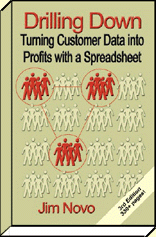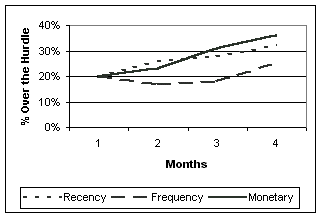Tracking the Potential Profitability
of B2C CRM Implementations
First Published: "Tracking
the Potential Profitability of B2C CRM Implementations"
CRM IT Toolbox 10/10/00
If you're looking to discover the potential
ROI of a CRM project "pre-CRM," see this
article.
The following article is from
the advanced topics section; you might want to take the tutorial Comparing the Potential Value
of Customer Groups before reading it. If you would rather see a general
description of the Drilling Down method and specific benefits first, go to
the home page.
Overview
Now that a number of large scale CRM implementations
have been completed and many more are underway, issues have surfaced
regarding measuring the payback on these implementations. Will the
company ever experience a positive Return on Investment with CRM, given
the complexity and cost of implementation?
CRM can generate increased profitability for your business in two ways:
1. Reducing costs, usually in the call center or distribution system
(operational CRM). The analysis of ROI benefits here is usually
pretty simple if you understand current operating costs in detail.
2. Increasing customer value (LifeTime Value) through marketing
(analytical CRM). ROI analysis in this area is usually a bit more
complex, particularly if the company lacks experience in really using
customer data to increase customer profitability.
Clearly, to correctly answer this question, standards or
goals for payback and measurement should have been established up front,
and companies should have established their own measurement
criteria. However, some of these companies are unfamiliar with the
direct customer contact business model in general, and database
marketing metrics in particular. These companies may find it more
difficult to accurately measure payback.
For example, there may be cost reductions or
efficiencies created by the CRM implementation which are relatively easily
measured (talk time, etc.) and used to offset the CRM costs. But if the explicit theory of CRM – improving customer
retention and loyalty will increase customer valuation – is accurate,
then the payoff for a CRM implementation should also include the
likelihood of increased customer value in the future. To not take
this factor into account would miss a potentially large offset to CRM
implementation costs.
This article describes a universally applicable, simple
to implement set of criteria for measuring the direct effects to future
customer value of a CRM implementation in the B2C space. It will be
especially useful to companies without a long-term history of direct
customer contact, who may be having difficulty accurately measuring the LifeTime
Value of their various customer segments. This method allows a
company to start the measurement process at "today," meaning
there is no requirement for a long operating history, intense analytical
techniques, or direct surveys of customers.
For those more familiar with database marketing
measurement techniques, the following is a derivation of RFM
analysis,
allowing a very simplistic scoring of the customer database, and
monitoring positive or negative changes in future customer valuation using
these scores.
Note the methods in this article will also be applicable
to some B2B companies, for example, those serving the SOHO (Small Office /
Home Office) segment, or B2B environments consisting of multi-transaction
customer controlled interactions (like ordering office supplies).
The methods demonstrated here are likely to break down in high ticket,
long sales cycle B2B markets, such as enterprise software and hardware.
Background
For several decades now, the catalog industry has been
studying direct customer contact strategies and tactics, and dealing with
handling the customer service implications of conducting business in this
way. Over time, they have developed models directly linking the
future value of a customer to the business with the customer’s
behavior. Recent work in the TV shopping industry, the first 24
x 7 "interactive" customer shopping experience, and on the Web,
have confirmed these models developed for the catalog industry have direct
application to interactive customer behavior in multi-channel direct
contact environments.
The most powerful and simplest to implement of these
models is called RFM – Recency, Frequency, and Monetary value. RFM
is a behavior-based model, meaning it is used to analyze the behavior a
customer is engaging in, and make predictions based on this behavior. The
RFM model states three conditions:
The more Recently someone has engaged in a
behavior, the more likely they are to repeat the same behavior, especially
if prompted.
The more Frequently someone has engaged in an
behavior, the more likely they are to repeat the same behavior, especially
if prompted.
The more Monetary value someone has created by
purchasing, the more likely they are to continue to purchase, especially
if prompted.
RFM has a corollary: The more likely a person is to do
something, the higher their response rate will be when you ask them to do
it. Customers who have purchased or visited more Recently, more
Frequently, or created higher Monetary values are much more likely to
respond to your marketing efforts, compared with other customers who are
less Recent, less Frequent, and create less Monetary value.
RFM Links to Lifetime Value
Classic RFM implementation ranks each customer on the
Recency, Frequency, and Monetary value parameters against all the other
customers, and creates an RFM "score" for each customer.
Customers with high scores are usually the most profitable, the most
likely to repeat a behavior (visit or purchase, for example), and the most
highly responsive to promotions. The opposite is true for customers
with low RFM scores.
Assuming the behavior being ranked using RFM has
economic value, the higher the RFM score, the
more profitable the customer is to the business now and in the
future. For this reason, RFM is closely related to another database
marketing concept: LifeTime Value (LTV). LTV is the expected net
profit a customer will contribute to your business as long as the customer
remains a customer.
Because of the linkage to LTV, RFM techniques can be
used as a proxy for the future profitability of a business. High RFM
customers are most likely to continue to purchase and visit, AND they are
most likely to respond to marketing promotions; these customers likely
have the highest LifeTime Value. The opposite is true for low RFM
customers; they are the least likely to purchase or visit again AND the
least likely to respond to marketing promotions; these customers tend
to have low LTV.
High RFM scores represent future business potential,
because the customers are willing and interested in doing business with
you, and have high LTV. Low scores represent dwindling business
opportunity, low LTV, and are a flag something needs to be done with those
customers to increase their value.
One simple application of RFM is Hurdle Rate Analysis,
where "hurdles" are selected for Recency, Frequency, and
Monetary Value, and the entire customer base is evaluated against these
hurdles as a group.
A Hurdle Rate is simply the percentage of your
customers who have at least a certain activity level for Recency,
Frequency, and Monetary value. It’s the percentage of
customers who have engaged in a behavior since a certain date (Recency),
engaged in a behavior a certain number of times (Frequency), or have
purchased a certain amount over time (Monetary value).
Because of the link between RFM and Lifetime Value, it
can be concluded:
If the percentage of customers over each hurdle
(Recency, Frequency, Monetary value) is growing, the business is healthy
and thriving. Customers are responding positively to the experience
they receive, and as a group are more likely to engage in profit
generating behavior in the future.
If the opposite is true, and the percentage of customers
over each hurdle (Recency, Frequency, Monetary value) is falling over
time, high value customers are defecting and the future value of your
business is falling. Customers as a group are responding negatively
to the overall service they are receiving.
A business should expect a successful CRM
implementation, because of all it implies for customer satisfaction and
productivity (cross-selling, etc.), would result in rising Hurdle
Rates. An unsuccessful implementation would cause falling Hurdle
Rates, and an implementation with no effect would drive no change in
Hurdle Rates.
Sample Hurdle Rate Implementation
If the business has an understanding of customer
LifeCycles, the logical Hurdle Rates to set for Recency, Frequency,
and Monetary value would equate to customer behavior at primary changes in
the customer LifeCycle.
For example, if it was known customers who have not
purchased for 60 days rarely make another purchase, the logical hurdle to
set for Recency is 60 days. Sweep the database and determine the
percentage of customers who engaged in purchase behavior in the past 60
days; this is the starting Hurdle Rate. If 20% of customers have
made a purchase in the last 60 days, 20% is the starting Hurdle
Rate. The same approach would hold true for Frequency and Monetary
value of purchases.
If the business is very new or has never studied the
customer LifeCycle, then a good default position to use is based on the
20/80 rule (20% of customers generally generate 80% of the behavior, be it
sales, visits, etc.) The analysis would default to a "starting
Hurdle Rate" of 20% for each behavior, and examine the customer base
to determine RFM values corresponding to the 20% hurdle.
In this case, the business would look at the top 20% of
their customers for each of the Recency, Frequency, and Monetary value
parameters, and examine the "tail end" customers – the bottom
customers of the top 20%. These values would become the hurdles the
customer base is judged against. This exercise is completed for each
of the RFM parameters and tracked over time.
For example, in a database of 10,000 customers, to
determine the Recency hurdle using the 20/80 rule:
1. Select the behavior to be profiled –
purchases, visits, etc.
2. Sort customers by most Recent date of the
behavior you are profiling
3. Starting at the most Recent customer, count
down to customer number 2,000 (20% of 10,000) in this sorted
database. Examine the group of customers near this target level,
perhaps customer 1,950 to customer 2,050
4. Determine how long ago these customers, on
average, engaged in the behavior you are profiling based on last
activity date
5. You find these customers last purchased an
average of 60 days ago
6. The Recency hurdle becomes 60 days for the
"today" or starting Hurdle Rate of 20%
Regardless of whether the Hurdle Rate is set using the
customer Lifecycle or the 80/20 rule, the operational implementation is
the same. Each week or month, sweep the database and determine the
percentage of customers who have engaged in the behavior within the hurdle
definition. For a 60-day hurdle, it would be the percentage of
customers engaging in the behavior in the past 60 days.
If the percentage of customers "over the
hurdle" (engaging in the behavior less than 60 days ago) grows over
time, the Recency Hurdle rate is rising, and the future value of the
customer base (LTV) is rising. If the percentage of customers
"over the hurdle" is falling, the Recency Hurdle Rate is falling
and future value is falling as well.
This exercise can be completed on the same behavior for
Frequency, and if there is a transactional value to the behavior (a
purchase), for Monetary Value as well. Additional behaviors can also
be monitored simultaneously; on the web, tracking purchases and visits
together would make sense. Unless the business has a very clear
understanding of revenue per visit across different areas of the site, it
is unlikely tracking the Monetary Value of visits would be very useful.
The Hurdle Rate values can be graphed over time, and
trends established. Clearly there will be fluctuations up and down,
and seasonality in retail or event oriented businesses. But if solid
trends in Hurdle Rates develop in either direction, or year over year
comparisons are dramatically different for a seasonal business, the
measurement should be judged to be significant and actionable.
Graphing Hurdle Rates over time provides an easy way to present a somewhat
complex subject to management: line up = good, line down = bad.
Hurdle Rates in Action
Percentage of Customers
Over Various Hurdles - 4 months
The lines in the chart show the percentage of customers
over each Hurdle tends to be rising over time. This particular chart
is a combination of behaviors and RFM parameters – Recency of Visit (R),
Frequency of Purchase (F), and Monetary value of Purchases (M). For
Hurdles, 30 day Recency, 10 unit Frequency, and $500 Monetary were
selected.
The percent of customers who have visited in the last 30
days (Recency, broken heavy line) is rising. The percent of
customers who have purchased over 10 items (Frequency, heavy solid line)
is rising. The percent of customers who have spent over $500 in
total (Monetary Value, light solid line) is also rising. A business
can mix and match tracking of behaviors and Hurdle Rates according to
priorities in the business model.
This is the picture of "growing the share" of
best customers in your customer database. Your best customers are
remaining with you, and other customers are "growing into"
becoming best customers. This is the effect desired in a positive
CRM implementation.
If you don’t see this effect, and the CRM
implementation is not reducing costs, the CRM package
is not paying for itself. Higher customer activity levels among best
customers are just not happening, and it is precisely these customers who
are most likely to be affected by CRM, and would contribute the most
future value towards paying off the CRM implementation.
Additional Hurdle Rate Considerations
Hurdle Rate analysis, like any good "lift"
analysis, assumes there is only one significant variable being measured,
in this case, the CRM implementation. If the business makes radical
changes to product offerings, or adopts a new business model during the
CRM implementation, Hurdle Rates (and most other kinds of analysis) are
not going to be able to tell which changes are really affecting the
customer base, positively or negatively. If direct cause and effect
measurement is required, a basic assumption in a CRM implementation should
be "keep everything else as stable as possible."
The direct linkage between RFM and LTV can break down
for specific customers where costs related to the customer are much higher
than the average customer. This would include customers with extreme
acquisition costs, customers with significant return rates, or customers
with high after-the-sale maintenance costs. For these customers, it
is possible to have a high RFM score and low LifeTime Value, so the
linkage breaks down. In most businesses, it would not be true that
the "best customers" from a sales or visit volume standpoint are
also the least profitable, and that low volume customers are the most
profitable. If this is the case, there clearly is an inverse link
between RFM and LTV, and the approach used above should be inverted; that
is, falling Hurdle Rates are good for the business. This is a
business surely headed for bankruptcy, as less customer activity and
satisfaction is more profitable to the business, meaning zero activity is
maximum profitability. For some business models, this is probably
true.
For those not familiar with classic RFM analysis, the
sequence of the characters R-F-M is intentional. Recency is by far
the strongest predictive variable, followed by Frequency, then Monetary
Value. Lacking the resources or ability to track all three on any
particular behavior, start with Recency. You can add the others
later as resources become available. Recency of a behavior is the single
most powerful predictor of the behavior repeating, and of response to any
promotional efforts.
A business with a lot of "noise" in the
customer base may want to exclude this noise before calculating hurdles
and Hurdle Rates. For example, if there are a lot of one-time
buyers, or visitors with only a few visits, excluding these customers
completely (like they didn’t even exist) in the above process will lead
to more accurate and meaningful analysis. These customers tend to
"dilute" the process by lowering the threshold for defining a
good (top 20%) customer.
If you are looking for a "hard match" on
incremental profits generated versus the cost of a CRM implementation, you
will need to fully understand customer segmentation and valuation prior
to the implementation. Without this knowledge to serve as a
"control" to measure later results against, the capability to
definitively measure profit gains and match these with costs will be
lost. A fairly simple way to handle this is to look at customer
profitability by decile before and after the CRM implementation.
This is extensive work, requires excellent customer history files, and
embodies the kind of thinking a business should have a grasp on in order
to successfully implement CRM in the first place.
The Hurdle Rate method described above is a
fast, easy to implement method to get a business started on the
measurement of success right away without a lot of detailed financial
history on their customers.
The decile measurement approach for more
mature businesses with defined customer financial history is described here.
After measuring customer group value, the next step is to manage
customer value - to make money by creating very high ROI customer
marketing campaigns and site designs. The Drilling Down book
describes how to create future value and likelihood
to respond scores for each customer, and provides detailed instructions on how to
use these scores to continuously improve profitability.
| 
![]()

